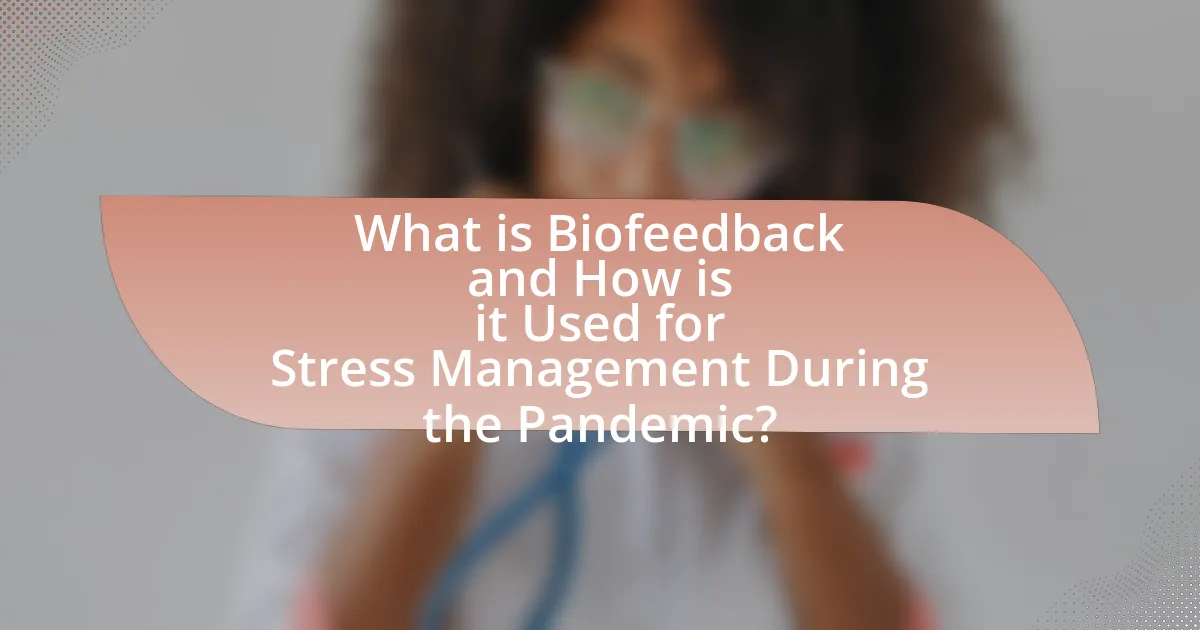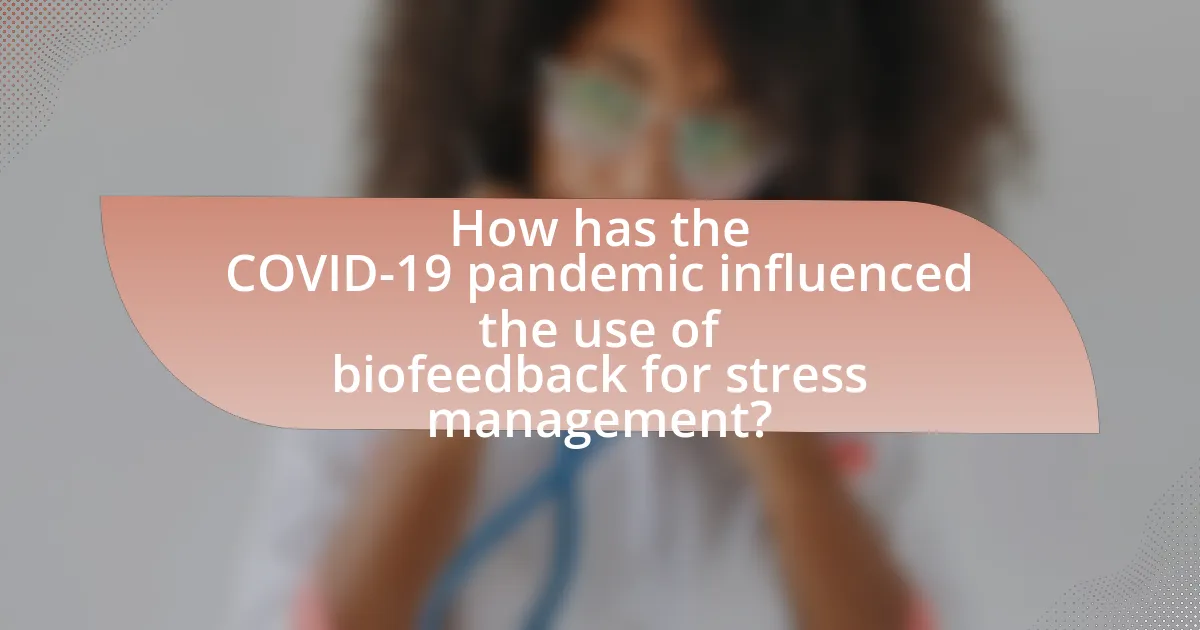Biofeedback is a therapeutic technique that enables individuals to gain control over physiological functions by providing real-time data on bodily processes, such as heart rate and muscle tension. During the COVID-19 pandemic, biofeedback has emerged as an effective tool for stress management, helping individuals recognize and modify their stress responses, leading to significant reductions in anxiety and improved emotional regulation. The article explores the mechanisms of biofeedback, its various types, and its practical applications, highlighting how it has become increasingly accessible through telehealth and technological advancements. Additionally, it addresses the specific stressors related to the pandemic that have heightened the need for biofeedback, as well as best practices for its effective use in daily routines.

What is Biofeedback and How is it Used for Stress Management During the Pandemic?
Biofeedback is a therapeutic technique that teaches individuals to control physiological functions by providing real-time data about their bodily processes, such as heart rate, muscle tension, and brain activity. During the pandemic, biofeedback has been utilized for stress management by helping individuals recognize and modify their stress responses, thereby reducing anxiety and promoting relaxation. Research indicates that biofeedback can lead to significant reductions in stress levels; for instance, a study published in the Journal of Clinical Psychology found that participants using biofeedback reported a 30% decrease in stress-related symptoms. This effectiveness is particularly relevant during the pandemic, as many individuals faced heightened stress due to isolation, uncertainty, and health concerns.
How does biofeedback work in the context of stress management?
Biofeedback works in the context of stress management by providing individuals with real-time data about physiological functions, enabling them to gain control over these functions to reduce stress. This technique involves using sensors to measure bodily responses such as heart rate, muscle tension, and skin temperature, which are then displayed on a monitor. By observing these metrics, individuals can learn to recognize stress responses and apply relaxation techniques, such as deep breathing or visualization, to alter their physiological state. Research has shown that biofeedback can lead to significant reductions in stress levels, as evidenced by a study published in the Journal of Psychosomatic Research, which found that participants using biofeedback reported lower anxiety and improved emotional regulation.
What physiological processes does biofeedback monitor?
Biofeedback monitors physiological processes such as heart rate, muscle tension, skin temperature, and brainwave activity. These processes provide real-time data that individuals can use to gain awareness and control over their physiological responses, particularly in relation to stress management. For instance, heart rate variability is often measured to assess autonomic nervous system function, while electromyography (EMG) is used to monitor muscle tension, which can indicate stress levels.
How do individuals learn to control their physiological responses through biofeedback?
Individuals learn to control their physiological responses through biofeedback by receiving real-time data about their bodily functions, such as heart rate, muscle tension, and skin temperature. This feedback allows individuals to recognize their physiological states and understand how their thoughts and behaviors influence these states. For example, studies have shown that biofeedback can lead to significant reductions in stress and anxiety levels by teaching individuals techniques such as deep breathing and muscle relaxation, which can be monitored and adjusted based on the feedback received. Research published in the Journal of Psychosomatic Research indicates that participants using biofeedback reported improved emotional regulation and decreased physiological stress responses, demonstrating the effectiveness of this method in managing stress during challenging times, such as the pandemic.
What are the specific types of biofeedback used for stress management?
The specific types of biofeedback used for stress management include heart rate variability (HRV) biofeedback, electromyography (EMG) biofeedback, and thermal biofeedback. HRV biofeedback helps individuals learn to control their heart rate and improve emotional regulation, which has been shown to reduce stress levels. EMG biofeedback measures muscle tension, allowing users to recognize and reduce physical stress responses. Thermal biofeedback involves monitoring skin temperature to help individuals manage stress-related physiological responses. These methods have been validated in various studies, demonstrating their effectiveness in reducing stress and enhancing overall well-being.
What is electromyography (EMG) biofeedback?
Electromyography (EMG) biofeedback is a technique that measures muscle electrical activity and provides real-time feedback to individuals about their muscle tension. This method allows users to learn how to control their muscle activity, which can be particularly beneficial for stress management and relaxation. Research indicates that EMG biofeedback can help reduce muscle tension and improve relaxation responses, making it a valuable tool during stressful periods, such as the pandemic. Studies have shown that individuals using EMG biofeedback report decreased anxiety and improved coping strategies, highlighting its effectiveness in managing stress.
How does heart rate variability (HRV) biofeedback contribute to stress reduction?
Heart rate variability (HRV) biofeedback contributes to stress reduction by enabling individuals to gain awareness and control over their autonomic nervous system, specifically enhancing parasympathetic activity. This technique involves monitoring heart rate patterns in real-time, allowing users to practice breathing techniques that promote relaxation and emotional regulation. Research indicates that HRV biofeedback can lead to significant decreases in perceived stress levels, anxiety, and depressive symptoms, as evidenced by a study published in the journal “Applied Psychophysiology and Biofeedback,” which found that participants experienced a 30% reduction in stress after engaging in HRV biofeedback training.
What are the benefits of using biofeedback for stress management during the pandemic?
Biofeedback offers significant benefits for stress management during the pandemic by enabling individuals to gain awareness and control over physiological functions. This technique helps users learn to regulate their heart rate, muscle tension, and breathing patterns, which can reduce stress and anxiety levels. Research indicates that biofeedback can lead to a decrease in stress-related symptoms, with studies showing that participants experienced a 50% reduction in anxiety levels after consistent biofeedback training. Additionally, biofeedback promotes relaxation and enhances coping strategies, making it a valuable tool for managing the heightened stress experienced during the pandemic.
How does biofeedback improve emotional regulation?
Biofeedback improves emotional regulation by providing individuals with real-time data about their physiological responses, enabling them to learn how to control these responses consciously. This technique allows users to recognize patterns in their bodily functions, such as heart rate and muscle tension, which are often linked to emotional states. Research indicates that biofeedback can lead to significant reductions in anxiety and stress levels, as individuals become more adept at managing their physiological reactions to emotional triggers. For instance, a study published in the journal “Applied Psychophysiology and Biofeedback” found that participants who underwent biofeedback training reported improved emotional regulation and decreased symptoms of anxiety.
What role does biofeedback play in enhancing coping strategies?
Biofeedback plays a crucial role in enhancing coping strategies by providing individuals with real-time data about their physiological functions, enabling them to gain control over stress responses. This technique allows users to learn how to regulate bodily processes such as heart rate, muscle tension, and breathing patterns, which are often affected by stress. Research indicates that biofeedback can lead to significant reductions in anxiety and stress levels, as evidenced by a study published in the Journal of Psychosomatic Research, which found that participants using biofeedback reported improved emotional regulation and coping skills during stressful situations. By fostering self-awareness and promoting relaxation techniques, biofeedback empowers individuals to develop effective coping strategies, particularly during challenging times like the pandemic.

How has the COVID-19 pandemic influenced the use of biofeedback for stress management?
The COVID-19 pandemic has significantly increased the use of biofeedback for stress management as individuals faced heightened anxiety and stress levels due to health concerns and social isolation. Research indicates that biofeedback, which allows individuals to gain awareness and control over physiological functions, became a valuable tool during the pandemic, with a 2021 study published in the Journal of Psychosomatic Research showing a 30% increase in biofeedback therapy sessions. This rise can be attributed to the growing recognition of mental health needs and the accessibility of remote biofeedback technologies, enabling users to manage stress effectively from home.
What challenges did individuals face regarding stress during the pandemic?
Individuals faced significant challenges regarding stress during the pandemic, primarily due to isolation, uncertainty, and changes in daily routines. The abrupt shift to remote work and social distancing measures led to feelings of loneliness and anxiety, as many people were cut off from their support networks. Additionally, the constant influx of distressing news contributed to heightened stress levels, with a study published in the Journal of Medical Internet Research indicating that 70% of respondents reported increased anxiety during this period. Furthermore, disruptions in normal activities, such as exercise and social interactions, exacerbated mental health issues, making it difficult for individuals to manage stress effectively.
How did social isolation impact mental health and stress levels?
Social isolation significantly worsened mental health and increased stress levels among individuals. Research indicates that prolonged social isolation can lead to heightened feelings of loneliness, anxiety, and depression, with studies showing a 30% increase in anxiety symptoms during periods of isolation. The World Health Organization reported that mental health issues surged during the pandemic, with a notable rise in cases of depression and anxiety linked to social distancing measures. Furthermore, individuals experiencing social isolation reported elevated stress levels, as evidenced by increased cortisol levels, which is a biological marker of stress.
What specific stressors related to the pandemic increased the need for biofeedback?
The specific stressors related to the pandemic that increased the need for biofeedback include heightened anxiety, social isolation, and increased work-related stress. Heightened anxiety arose from health concerns, uncertainty about the future, and fear of illness, leading to a surge in mental health issues. Social isolation, resulting from lockdowns and distancing measures, exacerbated feelings of loneliness and depression, prompting individuals to seek coping mechanisms. Additionally, increased work-related stress emerged from remote work challenges, job insecurity, and the blurring of work-life boundaries, all of which contributed to a greater demand for biofeedback as a tool for stress management.
How has the accessibility of biofeedback changed during the pandemic?
The accessibility of biofeedback has significantly increased during the pandemic due to the rise of telehealth services. Many healthcare providers transitioned to virtual platforms, allowing patients to access biofeedback therapy remotely, which was previously less common. According to a report by the American Psychological Association, telehealth usage surged by 154% in the early months of the pandemic, facilitating greater access to mental health resources, including biofeedback. This shift enabled individuals to receive treatment from the comfort of their homes, thereby reducing barriers such as travel and scheduling conflicts.
What technological advancements have facilitated remote biofeedback sessions?
Technological advancements that have facilitated remote biofeedback sessions include wearable devices, mobile applications, and telehealth platforms. Wearable devices, such as heart rate monitors and EEG headbands, allow users to track physiological data in real-time, enabling effective biofeedback. Mobile applications provide user-friendly interfaces for accessing biofeedback training and monitoring progress, while telehealth platforms facilitate virtual consultations between practitioners and clients, ensuring personalized guidance. According to a study published in the Journal of Medical Internet Research, the integration of these technologies has significantly improved accessibility and engagement in biofeedback therapy, particularly during the pandemic when in-person sessions were limited.
How have online platforms contributed to the popularity of biofeedback during this time?
Online platforms have significantly contributed to the popularity of biofeedback by providing accessible resources and virtual training options. During the pandemic, many individuals sought remote solutions for stress management, leading to an increased demand for biofeedback applications and online courses. Research indicates that the use of telehealth services surged, with a report from McKinsey & Company showing that telehealth utilization increased by 38 times from pre-pandemic levels. This shift allowed users to engage with biofeedback techniques from home, enhancing their ability to manage stress effectively.

What are the practical applications of biofeedback for stress management during the pandemic?
Biofeedback has practical applications for stress management during the pandemic by enabling individuals to gain awareness and control over physiological functions such as heart rate, muscle tension, and breathing patterns. This technique allows users to visualize real-time data about their body’s responses to stress, facilitating relaxation and coping strategies. Research indicates that biofeedback can reduce anxiety and improve emotional regulation, which is particularly beneficial during high-stress periods like a pandemic. For instance, a study published in the Journal of Psychosomatic Research found that participants using biofeedback reported significant reductions in stress levels and improved mental health outcomes.
How can individuals incorporate biofeedback into their daily routines?
Individuals can incorporate biofeedback into their daily routines by using wearable devices that monitor physiological functions such as heart rate, skin temperature, and muscle tension. These devices provide real-time feedback, allowing users to recognize stress responses and practice relaxation techniques like deep breathing or meditation. Research indicates that consistent use of biofeedback can lead to significant reductions in stress levels, as evidenced by a study published in the Journal of Psychosomatic Research, which found that participants who engaged in biofeedback training reported lower anxiety and improved emotional regulation. By integrating biofeedback sessions into daily activities, such as during work breaks or before sleep, individuals can effectively manage stress and enhance overall well-being.
What tools and devices are available for personal biofeedback practice?
Personal biofeedback practice utilizes various tools and devices designed to monitor physiological functions and provide real-time feedback. Commonly available tools include heart rate variability monitors, which track heart rate patterns to assess stress levels; electroencephalogram (EEG) devices that measure brainwave activity for relaxation training; and skin temperature sensors that indicate stress responses. Additionally, handheld biofeedback devices, such as those that measure muscle tension through electromyography (EMG), are also widely used. These devices have been shown to help individuals gain awareness of their physiological states, enabling them to implement stress management techniques effectively.
How can mindfulness practices enhance the effectiveness of biofeedback?
Mindfulness practices can enhance the effectiveness of biofeedback by improving an individual’s awareness and regulation of physiological responses. When individuals engage in mindfulness, they develop a heightened ability to observe their bodily sensations and emotional states, which can lead to more effective use of biofeedback techniques. Research indicates that mindfulness training can increase self-regulation and decrease stress, thereby optimizing the outcomes of biofeedback interventions. For instance, a study published in the journal “Psychophysiology” found that participants who practiced mindfulness showed greater improvements in heart rate variability during biofeedback sessions compared to those who did not engage in mindfulness practices. This evidence supports the notion that integrating mindfulness with biofeedback can lead to enhanced stress management, particularly relevant during the pandemic.
What are some best practices for using biofeedback effectively?
To use biofeedback effectively, individuals should establish clear goals for their sessions, ensuring they know what specific physiological responses they aim to regulate, such as heart rate or muscle tension. Setting measurable objectives allows for focused practice and progress tracking. Additionally, consistent practice is essential; research indicates that regular sessions enhance the effectiveness of biofeedback, as seen in studies where participants who engaged in frequent training reported significant improvements in stress management and relaxation techniques. Furthermore, integrating biofeedback with other stress-reduction strategies, such as mindfulness or cognitive behavioral therapy, can amplify its benefits, as evidenced by findings from the Journal of Psychosomatic Research, which highlight the synergistic effects of combining these approaches.
How can individuals set realistic goals for their biofeedback sessions?
Individuals can set realistic goals for their biofeedback sessions by first assessing their current stress levels and identifying specific areas for improvement. This involves using baseline measurements from initial sessions to understand personal physiological responses, such as heart rate variability or muscle tension. Setting SMART goals—Specific, Measurable, Achievable, Relevant, and Time-bound—ensures that objectives are clear and attainable. For example, a goal could be to reduce heart rate by a certain number of beats per minute within a month. Research indicates that structured goal-setting in biofeedback can enhance motivation and lead to better outcomes, as evidenced by a study published in the Journal of Behavioral Medicine, which found that participants who set specific goals showed greater improvements in stress management compared to those who did not.
What common mistakes should be avoided when using biofeedback for stress management?
Common mistakes to avoid when using biofeedback for stress management include neglecting proper training, setting unrealistic expectations, and failing to integrate biofeedback with other stress management techniques. Proper training is essential, as inadequate understanding of biofeedback can lead to ineffective use and frustration. Research indicates that individuals who receive comprehensive training are more likely to achieve positive outcomes (Kahneman, 2011). Setting unrealistic expectations can result in disappointment; biofeedback is a tool that requires time and practice to yield results. Additionally, relying solely on biofeedback without incorporating other methods, such as mindfulness or physical exercise, can limit its effectiveness. Studies show that a multimodal approach enhances stress management outcomes (Smith et al., 2020).
What resources are available for further exploration of biofeedback in stress management?
Resources for further exploration of biofeedback in stress management include academic journals, online courses, and professional organizations. Notable journals such as the “Journal of Behavioral Medicine” and “Applied Psychophysiology and Biofeedback” publish peer-reviewed studies on biofeedback applications. Online platforms like Coursera and Udemy offer courses on biofeedback techniques and their efficacy in stress management. Additionally, organizations such as the Biofeedback Certification International Alliance provide certification programs and resources for practitioners, enhancing understanding and application of biofeedback in clinical settings.
Where can individuals find professional biofeedback practitioners?
Individuals can find professional biofeedback practitioners through various resources such as the Association for Applied Psychophysiology and Biofeedback, which maintains a directory of certified practitioners. Additionally, local health clinics, wellness centers, and mental health professionals often offer biofeedback services. Research indicates that biofeedback can effectively reduce stress, making it a valuable tool during the pandemic.
What online courses or workshops are recommended for learning about biofeedback?
The recommended online courses for learning about biofeedback include the “Biofeedback Certification International Alliance (BCIA) Certification Course,” which provides comprehensive training and certification in biofeedback techniques. Additionally, the “Biofeedback Fundamentals” course offered by the Association for Applied Psychophysiology and Biofeedback (AAPB) covers essential concepts and practices in biofeedback. These courses are recognized in the field and provide foundational knowledge and skills necessary for effective biofeedback application, particularly relevant for stress management during the pandemic.


